牛津上海版英语七年级下Unit1教案
- 格式:doc
- 大小:109.50 KB
- 文档页数:6
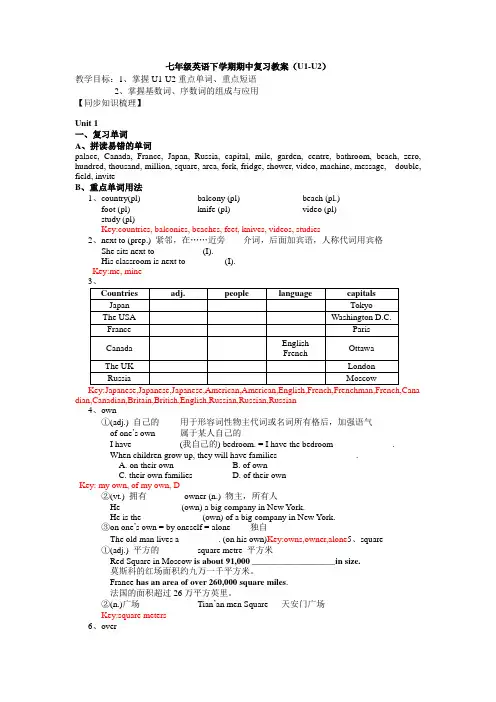
七年级英语下学期期中复习教案(U1-U2)教学目标:1、掌握U1-U2重点单词、重点短语2、掌握基数词、序数词的组成与应用【同步知识梳理】Unit 1一、复习单词A、拼读易错的单词palace, Canada, France, Japan, Russia, capital, mile, garden, centre, bathroom, beach, zero, hundred, thousand, million, square, area, fork, fridge, shower, video, machine, message, double, field, inviteB、重点单词用法1、country(pl)__________ balcony (pl) _________ beach (pl.)__________foot (pl)_____________ knife (pl)___________ video (pl)___________study (pl)__________Key:countries, balconies, beaches, feet, knives, videos, studies2、next to (prep.) 紧邻,在……近旁介词,后面加宾语,人称代词用宾格She sits next to___________(I).His classroom is next to_________(I).Key:me, minedian,Canadian,Britain,British,English,Russian,Russian,Russian4、own①(adj.) 自己的用于形容词性物主代词或名词所有格后,加强语气of one’s own 属于某人自己的I have___________(我自己的) bedroom. = I have the bedroom _____________.When children grow up, they will have families__________________.A. on their ownB. of ownC. their own familiesD. of their ownKey: my own, of my own, D②(vt.) 拥有owner (n.) 物主,所有人He______________(own) a big company in New York.He is the______________(own) of a big company in New York.③on one’s own = by oneself = alone 独自The old man lives a_________. (on his own)Key:owns,owner,alone5、square①(adj.) 平方的square metre 平方米Red Square in Moscow is about 91,000 ___________________in size.莫斯科的红场面积约九万一千平方米。

牛津英语七年级下册Unit1教案牛津7BUnit1第四课时教案教学内容(Teachingcontent):牛津初中英语7B第一单元词汇部分第四课时教学目的和要求:复习阅读部分内容及其知识点和句型表达;要求学生对词汇部分有全面的掌握本课类型:教授+操练教学方法:启发式教具准备:图片教学重点、难点和关键:用英文识别家具名称并能灵活使用为重点家具在一个家中的角色.通过学习这部分,如何使学生更深地理解家的概念是关键.教学过程:复习:Askingthestudentstotellwhosehomeheorshelikesbest andwhy.Byansweringthisquestion,wecangetthestudentst oreviewtheReadingpartwhilethinkingaboutwhathisorher idealhomeis.Itispossibletogetananswerlikethis:Ilikemadee’shomebestbecauseitisfuntoliveinahouseoverariverandc limbaladderintothehouseeveryday.Askingfiveorsixstudentstotellabouttheirideas.引入:Q:Homeisimportanttoeveryoneintheworld.whatdoyout hinkhomeis?Imightgetananswerlikethis:Ican’tfeelafraidorhungryathome.Lettingthestudentstalkaboutthequestionandhaveashort discussion.Q:whatmakesupofahome?Lettingthestudentsdiscussandthenpickingsomestudents totellabouttheirideas.Next,byshowingthemapictureoff amilymembers,apictureofahouseandapictureofdifferentroomsandfurniture,Icanmakethestudentsunderstandthat people,housesandfurnituremakeupofahome.Andtheyareal limportant.PEoPLE+HoUSE+FURNITURE=HomE授课内容及练习:ofcourse,withoutfamilymembers,there’snohome.Besidesfamilymembers,housesarethesecondmost important.Inahouse,weusuallyhavedifferentrooms.Basi cally,whatroomsdoneedinahouseforahome?sittingroomdiningroombathroombedroomkitchenstudybalconywealsoneeddifferentfurnitureindifferentrooms.Showin gthestudentssomepicturesoffurniture.whichroomdothey belongto?…Askingthestudentstonameoutthefurnituresaccordingtot heroompicturesshown.Sittingroom:sofacoffeetablearmchairlampTVDiningroom:diningtable.chair.napkinpaper.dinnerset.Bathroom:toilet.basin.shower.mirror.towel.Bedroom:bedbedsidetablelampdressingtablekitchen:cupboardcookermicrowaveovenfridgeStudy:bookshelflampcomputerNext,lookingatPartB.Simonismakingatableshowingtheob jectsindifferentroomsinNeil’shouse,buttherearesomemistakes.Helphimfindthemistak esandcirclethem.Askingthestudentstotakeouttheirfamilypicturesandtal kaboutyourhomewiththeirdeskmate…Askingsomestudentstocometothefrontandtalkabouthisor herhome…Discussion:Supposeyouhaveanemptyhouse.Butyouhaveonlytenthousan dyuan,whatfurniturewouldyouliketobuyfirst?Andwhy?小结:Askingthestudentstowriteasmanynamesoffurnitureasthe ycanwhileonestudentwritesontheblackboard.Atleastfiv eforeachroom.Thencheckingthewritingontheblackboardw iththestudents.作业布置:Pleasewritesomethingaboutthefurnitureyouneedorchang einyourhouserightnowandwhy.Atleast80words板书设计:PEoPLE+HoUSE+FURNITURE=HomEbedsidetable,lamp,coffeetable,sofa,cupboard,armchair↑↑↑↑↑↑bedroomsittingroomsittingroomkitchensittingroombedroombedroom教学后记:本课容量大,并有很大扩展,听、说、读、写都兼顾到;师生互动性强;在授课期间,要节奏快,引导和启发到位,确保学生的知识和能力都有收获.7BUnit1第2课时教案Reading1常州市第二十四中学英语组岳茵教学内容:7BUnit1第2课时Reading1教学目的及要求:1了解不同国家居住环境的情况。

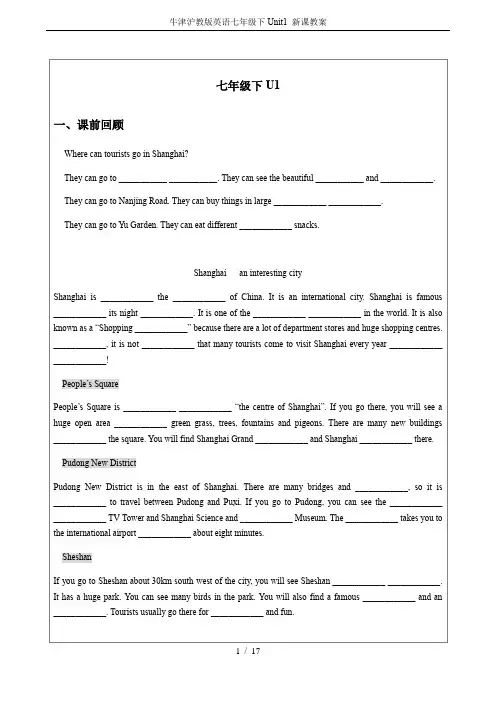
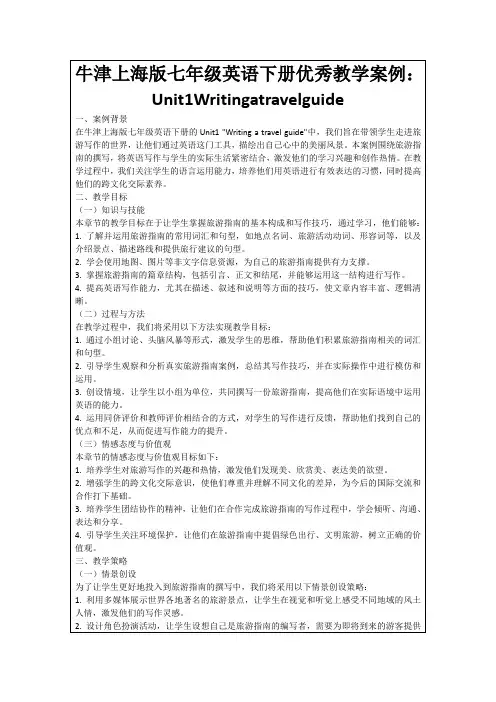
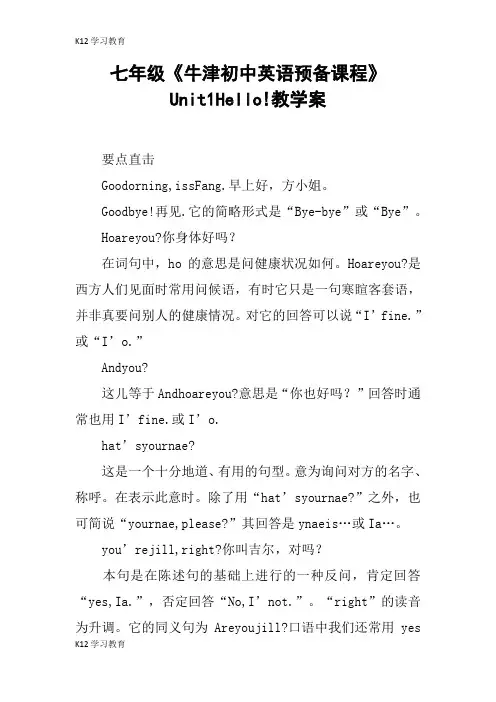
七年级《牛津初中英语预备课程》Unit1Hello!教学案要点直击Goodorning,issFang.早上好,方小姐。
Goodbye!再见.它的简略形式是“Bye-bye”或“Bye”。
Hoareyou?你身体好吗?在词句中,ho的意思是问健康状况如何。
Hoareyou?是西方人们见面时常用问候语,有时它只是一句寒睻客套语,并非真要问别人的健康情况。
对它的回答可以说“I’fine.”或“I’o.”Andyou?这儿等于Andhoareyou?意思是“你也好吗?”回答时通常也用I’fine.或I’o.hat’syournae?这是一个十分地道、有用的句型。
意为询问对方的名字、称呼。
在表示此意时。
除了用“hat’syournae?”之外,也可简说“yournae,please?”其回答是ynaeis…或Ia…。
you’rejill,right?你叫吉尔,对吗?本句是在陈述句的基础上进行的一种反问,肯定回答“yes,Ia.”,否定回答“No,I’not.”。
“right”的读音为升调。
它的同义句为Areyoujill?口语中我们还常用yes代替right。
如:“you’rejill,yes?”。
缩写形式I’是Ia的缩写形式;Ia是I’的完全形式。
hat’s是hatis的缩写形式;hatis是hat’s的完全形式。
you’re是youare的缩写形式;youare是you’re的完全形式。
Hello!你好!Hello通常用于以下四种情况:打招呼、打电话,表示惊讶或引起对方的注意。
意为“喂”、“你好”等。
Hello 等于hi,多用于非正式场合。
hi比hello使用时更随便,在美国青年人中使用更为普遍。
但是学生见到老师打招呼一般不说Hello,而应该说Goodorning!或Hoareyou?以免被认为不够礼貌。
0.有关字母的大小写句子开头个字母要大写。
人称代词单数主格I在句中任何位置都要大写。
例如:HeandIarestudents.他和我是学生。
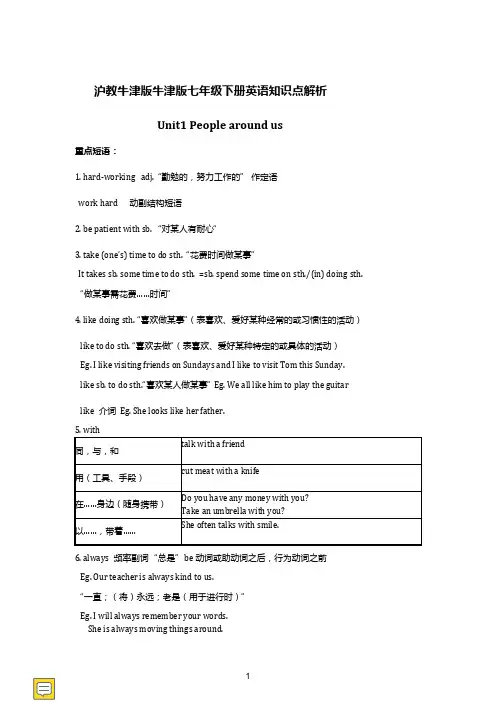
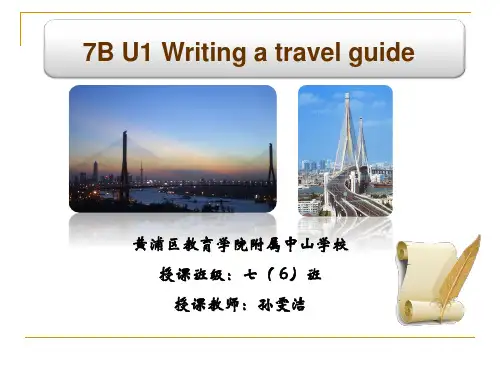
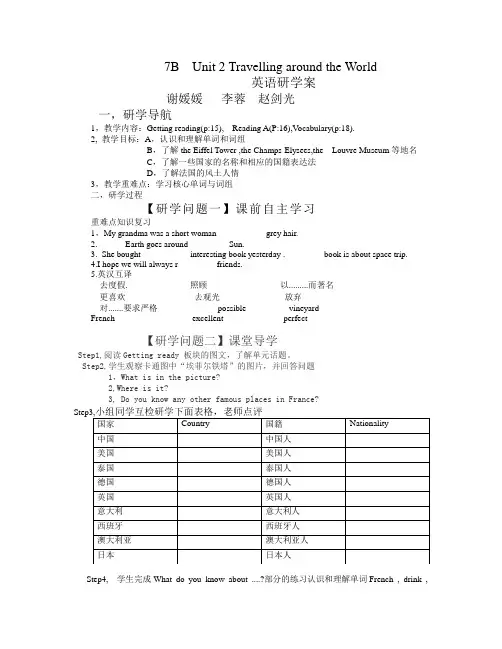
7B Unit 2 Travelling around the World英语研学案谢媛媛李蓉赵剑光一,研学导航1,教学内容:Getting reading(p:15), Reading A(P:16),Vocabulary(p:18).2, 教学目标:A,认识和理解单词和词组B,了解the Eiffel Tower ,the Champs-Elysees,the Louvre Museum等地名C,了解一些国家的名称和相应的国籍表达法D,了解法国的风土人情3,教学重难点:学习核心单词与词组二,研学过程【研学问题一】课前自主学习重难点知识复习1,My grandma was a short woman _________ grey hair.2.______ Earth goes around _______ Sun.3. She bought _________ interesting book yesterday ._______ book is about space trip.4.I hope we will always r_______ friends.5.英汉互译去度假._______ ____ 照顾_______________ 以.........而著名_________-更喜欢____________ 去观光____________ 放弃_____________对.......要求严格____________ possible________ vineyard___________French_____________ excellent__________ perfect__________【研学问题二】课堂导学Step1,阅读Getting ready 板块的图文,了解单元话题。
Step2,学生观察卡通图中“埃菲尔铁塔”的图片,并回答问题1,What is in the picture?2,Where is it?3, Do you know any other famous places in France?Step3,小组同学互检研学下面表格,老师点评国家Country 国籍Nationality中国中国人美国美国人泰国泰国人德国德国人英国英国人意大利意大利人西班牙西班牙人澳大利亚澳大利亚人日本日本人Step4, 学生完成What do you know about ....?部分的练习认识和理解单词French , drink ,flag , wine,以及短语(be )famous forStep 5 小组活动回答下面问题。
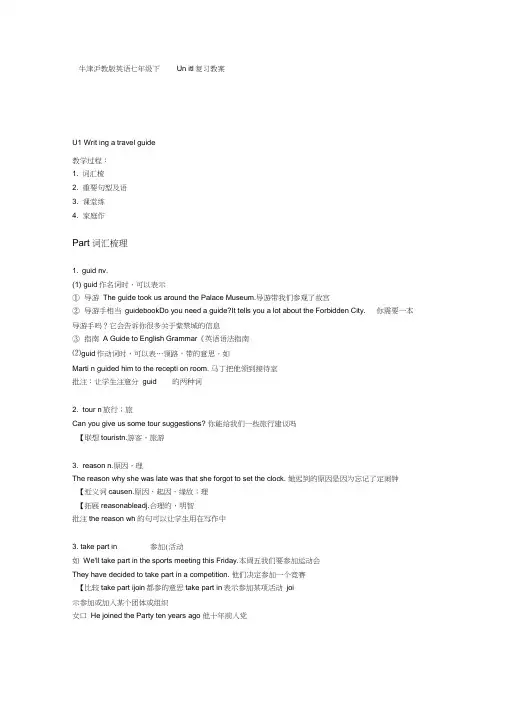
牛津沪教版英语七年级下Un itl复习教案U1 Writ ing a travel guide教学过程:1. 词汇梳2. 重要句型及语3. 课堂练4. 家庭作Part词汇梳理1. guid nv.(1) guid作名词时,可以表示①导游The guide took us around the Palace Museum.导游带我们参观了故宫②导游手相当guidebookDo you need a guide?It tells you a lot about the Forbidden City. 你需要一本导游手吗?它会告诉你很多关于紫禁城的信息③指南 A Guide to English Grammar《英语语法指南⑵guid作动词时,可以表…领路,带的意思。
如Marti n guided him to the recepti on room. 马丁把他领到接待室批注:让学生注意分guid 的两种词2. tour n旅行;旅Can you give us some tour suggestions? 你能给我们一些旅行建议吗【联想touristn.游客,旅游3. reason n.原因,理The reason why she was late was that she forgot to set the clock. 她迟到的原因是因为忘记了定闹钟【近义词causen.原因,起因,缘故;理【拓展reasonableadj.合理的,明智批注the reason wh 的句可以让学生用在写作中3. take part in 参加(活动如We'll take part in the sports meeting this Friday.本周五我们要参加运动会They have decided to take part in a competition. 他们决定参加一个竞赛【比较take part ijoin都参的意思take part in表示参加某项活动joi示参加或加入某个团体或组织女口He joined the Party ten years ago 他十年前入党I'll join the Youth League n ext mon th.下个月我要入团【提示take part in = join in批注:注take part injoi 的区4. sightsee ingn 观光;游Tourists usually go there for sightseei ng and fun 游客们通常会去那儿观光游玩【记忆go sightsee in去观【联想go shoppin 去购物go swimmin 去游泳go fishin 去钓鱼go travellin 去旅游11/ 1复习教案牛津沪教版英语七年级下Unit1去徒步旅行go boating去划船;go hiking go camping 去野营;go cycling 去骑车;去打猎go windsurfing 去风帆冲浪;go hunting go skating 去溜冰;观光旅游 a sightseeing tour【拓展】a sightseeing bus观光旅游车的中部位于... 5. in the cen tre ofin the middle of强调与四周距离相等的中心位置,常用来指空间;【比较】in the centre of强调两端之间的位置,并不强调中心,既可用于指空间,也可用于指时间。

牛津英语七年级预备课程Unit1教案The First Lesson[Teaching content]Unit 1 welcome and listening[Teaching aims and demands]Knowledge aims: 1. learn the new words2. learn how to greet each other when meetingAbility aims:1. Communicative ability, teach students to greet suitably at different times of a day.2. Cooperative ability, direct students to do lots of oral practice of greetings.[Teaching difficulties and importance]1. Pay attention to the spelling of these words: bye, hello, right , Mr, and Mrs.2. How to greet suitably at different times of a day and greet in different ways.[Teaching tools] Projector, Students’ book and W orkbook[Teaching steps]Pre-teaching1.Teach the new wordsAsk the students to read all of the new words before teaching. One students reads five words, so that the teacher can find out their mistakes in phonetics and then correct.2. Ask all students to read all of the new words, so that they are familiar with them before going into the text.3. The teacher needn’t lead them to read the new words, because those are words which students have already learned in the primary school, and they are all very easy and usual words.4. As for the spelling of the new words, there are some in which students always have difficulty, such as, bye (bey), hello (holle), right (right), Mr, and Mrs.Step 1. Warm-up and PresentationMake Ss recall the greetings which they learned in the primary school by doing some common and easy greetings with students, leading to the subject of this unit.Step 2. Welcome to this unit1.Ask students to read the four dialogues of this part for twice, and get ready for the following questions to check if the students understand the meaning of the dialogues:Who is Andy? Who is Millie? Who is Lily? Who is Nick? Who is Miss Fang? When they meet,what do they say? When they meet in the morning, what do they say? When they part(分别), what do they say?2.Teach students some similar words and similar sentences of the four dialogues, and at the same time ask them to replace all of the names in the dialogues with the thoses of their classmates. Therefore, students can make another four dialogues of their own and of different patterns but of the same meaning.For example, Hi= Hello, Good morning= Good morning to you,Good bye= Bye-bye, Bye, See you, see you around, see you later3.Pair work and a show timeStep 3 Listening1.Pre- listening.There is a clock on the wall in Picture 1 of Part A, so ask Ss for the correct time. After that the teacher guides the students to observe the times of the other three dialogues in this part and teaches the different ways of greeting.2.Ask students to do the listening exercises on the tape and tick thecorrect answer.3.Do some post-listening work. Guide students to replace all of thenames in the dialogues with the names of their classmates and use some similar words and similar sentences to make another dialogue of their own, so that Ss can know the different ways of greeting.For example, Good afternoon= Good afternoon to you, How are you = How are you doing,I’m fine= I’m OK, OK, Fine, Good, Great, hi= hello, And you= What about you,Thank you= Thanks4.Pair work and a show time5. Summary, ask Ss to find and learn these different ways to greet each other.1). You know each other:Hi, good morning / afternoon; How are you?2). You don’t know each other:Hello, what’s your name?3). You don’t know each other, but you know each other’s nam e:Hello, you’re ----, right?Step 4 Further knowledge and ability1.How are you?的回答一般是肯定,它的不同回答有:Fine, thank you. / I'm fine, thank you. / Not bad, thank you. /I'm OK/very well / All right./ Just so-so.身体状况确实不好,我们可以说:Not so good / Terrible / I don’t feeling very well.2. 对女性和男性的称呼如下:对男性我们一律称Mr. so and so,对未婚女性我们称Miss so and so, 而对已婚和不明婚姻状况的女性分别称Mrs. so and so, 和 Ms so and so.,并将Mr. Mrs.或Miss,Ms放在姓之前。
Unit 1教学案一、单元总述同学们,欢迎进入本单元学习!本单元是有关“梦想之家”这一主题内容。
你有自己梦想的家吗?会使用英语来描述一些国家和首都、房屋和家居设施的名称吗?本单元介绍了具有实用功能的描述“梦想之家”的用语,并介绍了一些家中使用物的词汇,还介绍了基数词、序数词和介词。
本单元通过问卷调查了解不同国家人的居住情况,启发同学们回想已学单词与新学词汇写一篇有关自己“梦想之家”的文章。
(一)教学目标:1.基础知识:单词:dream, palace, capital, balcony, cushion, beach, sea, bunk, town, wooden, over, climb, ladder, quiet, rain, while, sitting room, street, share, friendly, above, dining room, grow, most, lie, cupboard, bookshelf, shower, lamp, wardrobe, sink, bath, basin, in front of, opposite, chalk, air conditioner, below, printer, shelf, top, tidy, sixteen, nineteen, seventy, ninety, thousand, million, arrive, seventh, sixth, come, exam, second, third, fourth, fifth, ninth, eleventh, twelfth, twentieth, sound, bathroom, mirror, afraid, still, message, at least, ground floor, swimming pool, football pitch语法:序数词和基数词任务:问卷调查不同国家人的居住情况并写一篇自己的梦想之家的短文。
七下沪教版英语第一单元第6页摘要:一、前言二、本单元学习内容概述1.词汇和语法2.听说读写技能三、单元学习目标和计划1.学习目标2.学习计划四、教学方法和策略1.课堂活动2.课外练习五、总结与反思正文:一、前言七年级下学期的英语课程将继续学习英语的基本知识和技能,提高学生的听说读写能力,为更高年级的学习打下坚实基础。
本单元是第一单元,内容丰富,具有较高的实用性。
二、本单元学习内容概述1.词汇和语法本单元将学习一些新的词汇和语法知识,如动词的一般现在时、一般过去时和一般将来时,以及疑问句和祈使句等。
学生们将学会如何运用这些语法知识进行日常交流。
2.听说读写技能听说读写是英语学习的四个基本技能。
本单元将通过各种形式的课堂活动,如对话、短文阅读、听力训练等,提高学生的听说读写能力。
三、单元学习目标和计划1.学习目标通过本单元的学习,学生将能够掌握单元内的新词汇和语法知识,并能熟练运用这些知识进行日常交流。
2.学习计划本单元的学习计划分为五个阶段:预习、课堂学习、课后作业、复习和检测。
每个阶段都有具体的学习任务和要求,以确保学生能够扎实地掌握所学知识。
四、教学方法和策略1.课堂活动教师将采用情境教学法、任务型教学法等多种教学方法,引导学生积极参与课堂活动,提高学生的学习兴趣和动力。
2.课外练习教师将布置适当的课外练习,如词汇记忆、语法练习、阅读理解等,帮助学生巩固课堂所学知识,提高自主学习能力。
五、总结与反思本单元的学习将帮助学生掌握英语的基本知识和技能,为以后的学习打下坚实基础。
Module 2 Garden City and its neighboursUnit 1 Writing a tourist guide1Language focus:Asking ‘Wh-’ questions to find out various kinds of specific information about at event.e.g. What would you suggest the tourists do?Using modals to male suggestionse.g. I’d suggest they go to Shehan State Resort.Using proper nouns to refer to placese.g. I’d suggest they go to Yu Garden.Using adverbs to indicate Yu Garden.e.g. They can do some shopping there.Language skills:ListeningRecognize difference in the use of intonation in question, statements (including approval and disapproval), commands, and respond appropriately.Identily details that support a main idea.SpeakingUse appropriate intonation and stress, and vary volume, tone of voice, and speed to convey intended meanings and feelings.Maintain an interaction by replying, adding or giving examples.ReadingRecognize recurrent patterns in language structureRe-read to establish and confirm meaning.WritingDevelop written texts by presenting main and supporting ideasMaterials:Student’s Book 7B page 28Cassette 7B and a cassette playerSome picture of interesting places in ShanghaiPreparation:Cue the cassette.Collect some picture of interesting places in Shanghai.Pre-task preparation1. Bring some picture of the interesting places in Shanghai to class. Circulate them in class. Invite a few students to write the names of those places on the board.2. Go over the list on the board and correct any mistakes. The whole class then reads the list aloud together.3. Play the recording: Read and write. Students listen and follow in their books.4. Play the recording again. Students listen and repeat.5. Invite a few of more able students to role-play the conversation in class. Encourage them to add any other places of interest they can think of .2Language focus:Using proper nouns to refer to placese.g. Nanpu Bridge, Changfeng Park, …Asking ‘Wh-’ questions to find out various kinds of specific information about an evente.g. What would you suggest the tourist do?Using the introductory ‘there’ to express factse.g. There is / are …Language skills:ListeningUse appropriate intonation and stress, and vary volume, tone of voice, and speed to convey intended meanings and feeling.Maintain an interaction by replyingReadingUse visual clues, context and knowledge of the world to work out the meaning of an unknown word and acomplete expressionRecognize recurrent patterns in language structure.WritingGather and share information, ideas and language by using strategies such as brainstorming, listing, questioning, and interviewingPlan and organize information and ideas by identifying purpose and audience for a writing taskDevelop written texts by expressing own ideas and feelingsMaterials:Studen t’s Book 7B page 29Workbook 7B page 17Photocopiable page 25An enlarged copy of the map on page 29Preparation:Make an enlarged map of page 29. Make a copy of Photocopiable page 25 for each group.Pre-task preparation1. Make an enlarged copy of the map on page 29. Hang it on the board. Go over each place with the whole class.2. Point to the enlarged map and ask a few students: Which place(s) have you been to before? What can you see there? To elicit: I’ve been to …I can … /There is /are …3.Language focus:Using prepositions to indicate placee.g. Shanghai is in East China.Using connectives to express conditionse.g. If you go there, you will see …Using the introductory ‘there’ to express factse.g. There are many new buildings around.Using proper nouns to refer to placese.g. You will also see the famous Oriental Pearl TV Tower.Language skills:ListeningIdentify details that support a main idea.Use visual clues, context and knowledge of the world to work out the meaning of an unknown word and a complete expressionSpeakingMaintain an interaction by replyingReadingUse visual clues, context and knowledge of the world to work out the meaning of an unknown word and a complete expressionRecognize the presentation of ideas through headings, paragraphing, spacing, italics, bold print and punctuation. Skim a text to obtain a general impression and the main ideasMaterials:Student’s Book 7B page 30Cassette 7B and a cassette playerPreparation:Cue the cassette.4Language focus:Using connectives to express conditionse.g. If you go to Pudong New Area in the east of Shanghai, you will see the Nanpu Bridge.Using prepositions to indicate place.e.g. Places to visit in Puxi.Using proper nouns to refer to placese.g. the Bund, Sheshan State Resort.Language skills:ListeningUsing visual clues, context and knowledge of the world to work out meaning of an unknown word and a complete expression.Understand the connection between ideas by recognizing linking words and phrases.SpeakingUse a appropriate intonation and stress, and vary volume, tone of voice, and speed to convey intended meanings and feelingsReadingRead written language in meaningful chunksUse visual clues, context and knowledge of the world to work out the meaning of an unknown word and a complete expressionUnderstand the connection between ideas by identifying linking words or phrases.WritingGather and share information, idea and language by using strategies such as brainstorming, listing, questioning, and interviewing.Develop written texts by expressing own ideas and feelings.Materials:Student’s Book 7B page 31Cassette 7B and a cassette playerWorkbook 7B page 18Photocopiable page 26Preparation:Cue the cassette. Make a copy of Photocopiable page 26 for each student.Pre-task preparation1. Ask: How many of you have been to Pudong New Area/ the Nanpu Bridge/ Times square? Where is it?2. Play the rest of the recording: Look and read. Students listen and follow in their books.3. Play the recording again. Students listen and repeat.4. Show the students the contents page of a book. Tell them that a contents page outlines what a book is about.Post-task activityWorkbook page 18ConsolidationGrammar Practice Book 7B page 23 to 245Language focus:Using connective to express conditionse.g. If you go to Huaihai Road, you will find Times Square.Using the introductory ‘there’ and the impersonal ‘it’ to express facts.e.g. It is a popular place. There are …Using proper nouns to refer to placese.g. You will also see Century Park there.Language skills:SpeakingUse appropriate registers when speaking to familiar interlocutors such as teachers and peersUse gestures and facial expression to convey meaning and intentionWritingGather and share information, ideas and language by using strategies such as brainstorming, listing, questioning, and interviewingPlan and organize information and ideas by identifying purpose and audience for a writing taskDevelop written texts by expressing own ideas and feelingRevise and edit drafts by sharing work with teachers and suggestions on ideas and use of languageMaterials:Student’s Book 7B page 32Photocopiable page 27, 28 and 29Preparation:Make a copy of Photocopiable page 27,28 and 29 for each group. Remain each group to bring back Photocopiable page 25 to class.Pre-task preparation1. Review the following language structure with the class. Ask: If you go to Huaihai road /Huanghe Road / Pudong New Area, what will you find/see ? to elicit: If I go to (a place), I will find/see …2. Review: contents page. Ask a student: What’s a contents page? To elicit: A contents page outlines what a book is about.。
Unit 1 Writing a tourist guide一、单元分析(Unit Analysis)(一)单元地位(Unit Position)1 本课中出现了“If you go…, you will…”的条件状语从句。
这个句式在7A Module 3The natural elements Unit 3 Sea water and rain water中已经出现过。
如:If there is no rain, there will be no water to drink.等。
作为功能语言,教师有必要在课堂教学中加以一定的机械性训练。
2 I’d suggest they go …的用法也有较多出现,并且为首次出现,课文中主要结合上海的各个景点。
教师可以根据所在区域设计多个场景,让学生进行操练。
(二)单元目标(Unit Target)1 运用情态动词would来表达“建议”。
如: I’d suggest they go to NanjingRoad.2 运用if 句式表达条件。
如: If you go to Pudong New District in the east of Shanghai,you will see the Nanpu Bridge.3用专有名词来表示地点。
如:Yu Garden4运用there is/ are…,It is…句式来表示事实。
(三)单元重点(Unit Points)1 关键词:1)地方名称:Sheshan State Resort, Nanjing Road, Yu Garden, Shanghai Museum, People’s Square, Nanpu Bridge, Oriental Pearl TV Tower, Pudong New District,Water World, Shanghai Grand Theatre, the Municipal Hall。
2)固定短语:be famous for, be known as, in the world, in the east of, do some shopping。
3)其他:tourist, association, paradise, pigeon, suspension, observatory。
2 功能:1)Expressing conditions (表达条件)●If you go there, you will see a huge open area of green grass.2)Making suggestions(提出建议)●-What would you suggest the tourists do ?-I’d suggest they go to Nanjing Road.3 语法点:本课出现了不少if引导的条件状语从句的句式,应作为本课的知识点重点教学。
本课还多次出现了one of +the +形(最高级)+名词(复数),也是知识的重点。
二、教学设计(Teaching Designs)[链接1]以下内容中,主要是提供了一份小测试的表格。
本课时是在学生认识了“上海”各个名胜的基础上,进行句式的操练。
测试的目的在于帮学生一起领略上海的名胜,让学生在实施句型操练时有话说。
How Much Do You Know About Shanghai?List as many beautiful places as you can:●_________________________________●_________________________________●_________________________________●_________________________________●_________________________________●_________________________________●_________________________________●_________________________________●_________________________________…[链接2]说明:以下内容中,主要是提供了一份课本30页的一份教案。
本课时是在学生认识了“上海”整体情况的基础上,进行关于“if”句式的操练。
教学内容不难。
但我们有必要创设情景,让学生在情景中进行更深层次的操练。
如下,提供了一份本课时的完整教案。
Shanghai -an interesting cityI.Warming up1.Read the poem2.Sing the songII.GreetingT: Class begins. Good morning, boys and girls.S:T: Nice to see you here.S:T: Sit down, please.III. Pre-task PreparationT: Now we are here- in the center of Shanghai. Today we will learn some more information about Shanghai. First I’ll show you some photos of the interesting places in Shanghai. Please tell us what they are together.T: Are you ready?S:T: Let’s go.T: V ery good. I’m glad to see that you are so familiar with these interesting places in Shanghai. But Suppose I’m from Nanjing. I’m new here. What would you suggest I do?S: I’d suggest you go to…You can see…IV. While-task ProcedureT: Thank you for your suggestions! I’d suggest you go to People’s Square. You can see Shanghai Museum.T: That means: If you go to People’s Square, you will see Shanghai Museum.出示句型If you go to People’s Square, you will see Shanghai Museum.T: Read the sentence together.T: O.K. Please use the structure to introduce the interesting places in Shanghai again.S:T: Now who can tell us the difference between the two verbs in the sentence? You may say it in Chinese.S:T: Well done. In if-clause, we use the simple present tense while in the main clause, we use the simple future tense.T: Let’s come back to People’s Square. If you go there, you will see the Municipal Hall.(领读) You will see Shanghai Grand Theatre.( 领读) You will also see a huge open area of green grass and some pigeons. ( 领读)T: Please read them twice.T: Great How can we introduce People’s Square better? Let’s listen to the tape carefully. Then I will ask you some questions.Q1: What is People’s Square known as?Q2: What will you see if you go there?Q3: What are there around it?Q4: What else can you find?T: Please open your books and turn to Page 30. Let’s read the text after the tape sentence by sentence. (跟读一遍)Now shall we read it together?T: Now, we have known more about how to introduce a place better. Look, here are some pictures.Please work in pairs to introduce them with the given structures.V. Post-task activityT: In Shanghai, there are many interesting places. In Jinshan, there are also a lot of beautifulplaces such as Big Jinshan Island, Fengjing Town, the Beach, Beach V olleyball Match Stadium. T: Can you tell us more interesting places there?S:T: Excellent. Here I have got a piece of good news. In May, the World Beach V olleyball Matches will be held in JinShan again. Our school was asked to choose four students to show the foreigners around Jinshan. We will choose them in our class. Let’s have a competition. I will give each group a piece of paper and a pen. Please choose one picture to design a tourist guide in groups and make a poster as well. You should use what you have learnt today. Later, in each group, two of you will come to the front to report your guide and show your poster. Who will get the chance ? Just wait and see.T:T: Thank you very much. Who do you think will be the winners?S:T: It’s hard to say. You all did it well.T: The game will be held soon. The government are busy rebuilding our town.If you have the chance to design the future of Jinshan, what will you do to make it better? Why? Now discuss in groups.(出示幻灯)VI. SummaryWell, today. We mainly learned how to use if-clause to introduce a place. Of course, we let more people know more about Shang hai and JinShan. I’m sure you must have the same fe eling as I. We are so lucky to live in the beautiful city, nice town. We love our city, our town, don’t we? VII. AssignmentWrite a tourist guide about Jinshan[链接3][链接4]S1: If I work hard, I will get good marks.S2: If I get good marks, I will go to a good university. S3: If I go to a good university, I will have a good job. S4: If I have a good job, I will make a lot of money. …。